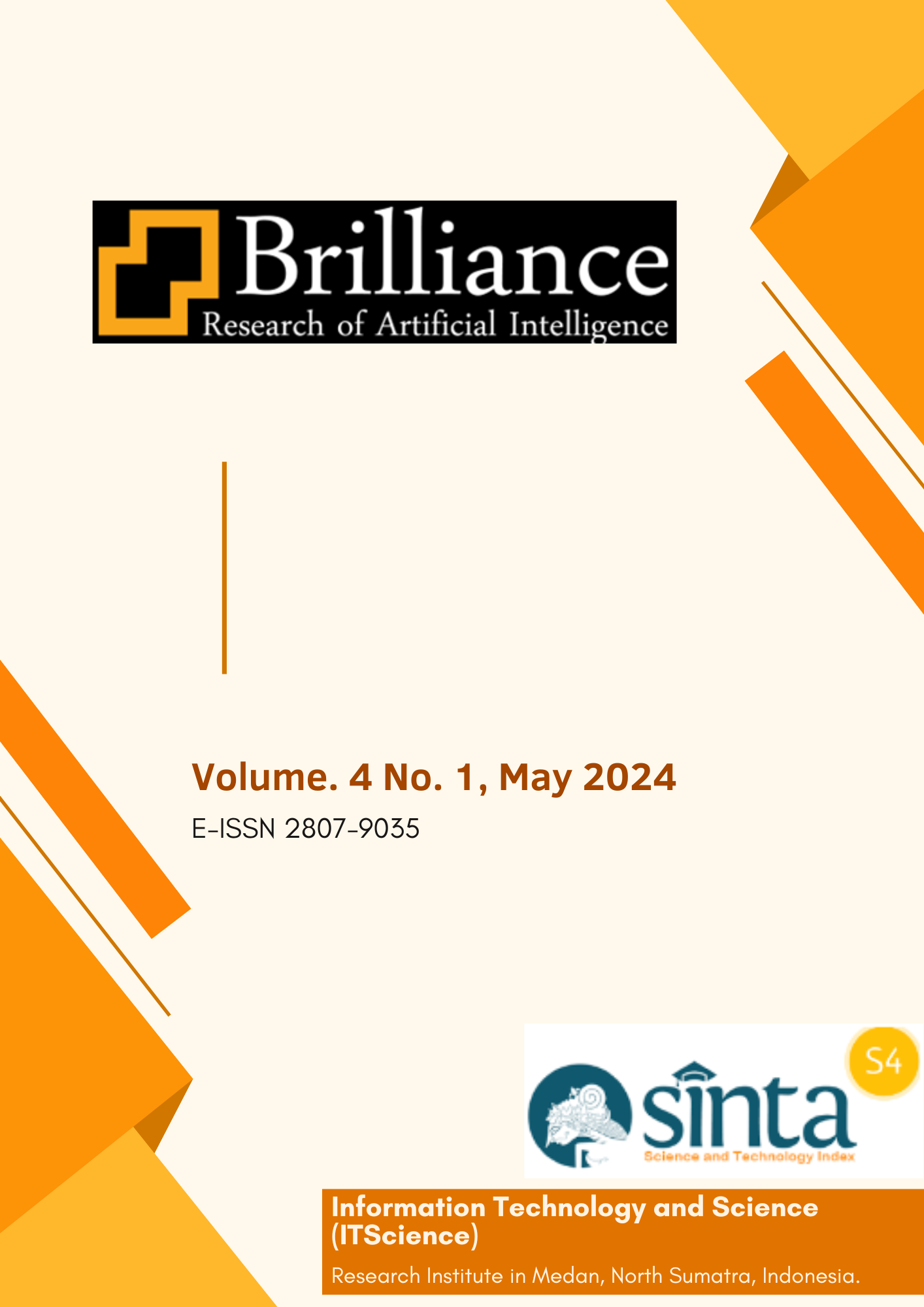Detection of Malware Threats in Internet of Things Using Deep Learning
DOI:
10.47709/brilliance.v4i1.3869Kata Kunci:
CNN, Deep Learning, Internet of Things, MalwareDimension Badge Record
Abstrak
This paper examines the potential risks associated with the Internet of Things (IoT) as a new gateway for cyberattacks. The continuous access it provides to systems, applications, and services within organizations increases the likelihood of serious threats, such as software piracy and malware attacks, which can result in the theft of sensitive information and significant economic losses. To address these concerns, researchers have proposed the use of Deep Convolutional Neural Network (DCNN) to detect malware infections in IoT networks by analyzing color image visualization. The malware samples were obtained from the Android Malware dataset on Kaggle. The proposed deep learning method, namely the Deep Convolutional Neural Network, was employed to detect malware infections in IoT networks.
Abstrak viewed = 120 times
Referensi
Abadi, M., Barham, P., Chen, J., Chen, Z., Davis, A., Dean, J., Devin, M., Ghemawat, S., Irving, G., Isard, M., Kudlur, M., Levenberg, J., Monga, R., Moore, S., Murray, D. G., Steiner, B., Tucker, P., Vasudevan, V., Warden, P., … Zheng, X. (2016). TensorFlow: A system for large-scale machine learning. http://arxiv.org/abs/1605.08695
Adrienne, A., Tato, N., Nkambou, R., & Tato, A. (2018). Workshop track-ICLR 2018 IMPROVING ADAM OPTIMIZER. https://doi.org/10.13140/RG.2.2.21344.43528
Association for Computing Machinery. Special Interest Group on Information Retrieval. (2013). SIGIR ’13?: the proceedings of the 36th International ACM SIGIR Conference on Research & Development in Information Retrieval?: July 28-August 1, 2013, Dublin, Ireland. ACM.
Baylor, D., Breck, E., Cheng, H. T., Fiedel, N., Foo, C. Y., Haque, Z., Haykal, S., Ispir, M., Jain, V., Koc, L., Koo, C. Y., Lew, L., Mewald, C., Modi, A. N., Polyzotis, N., Ramesh, S., Roy, S., Whang, S. E., Wicke, M., … Zinkevich, M. (2017). TFX: A TensorFlow-based production-scale machine learning platform. Proceedings of the ACM SIGKDD International Conference on Knowledge Discovery and Data Mining, Part F129685, 1387–1395. https://doi.org/10.1145/3097983.3098021
Dilhara, B. A. S. (2021). Classification of Malware using Machine learning and Deep learning Techniques. International Journal of Computer Applications, 183(32), 12–17. https://doi.org/10.5120/ijca2021921708
Elfwing, S., Uchibe, E., & Doya, K. (2017). Sigmoid-Weighted Linear Units for Neural Network Function Approximation in Reinforcement Learning. http://arxiv.org/abs/1702.03118
Haddi, E., Liu, X., & Shi, Y. (2013). The role of text pre-processing in sentiment analysis. Procedia Computer Science, 17, 26–32. https://doi.org/10.1016/j.procs.2013.05.005
Hu, J., Shen, L., Albanie, S., Sun, G., & Wu, E. (2020). Squeeze-and-Excitation Networks. IEEE Transactions on Pattern Analysis and Machine Intelligence, 42(8), 2011–2023. https://doi.org/10.1109/TPAMI.2019.2913372
IEEE Staff. (2018). 2018 9th IFIP International Conference on New Technologies, Mobility and Security (NTMS). IEEE.
Ji, W., Chen, G., Xu, B., Meng, X., & Zhao, D. (2019). Recognition Method of Green Pepper in Greenhouse Based on Least-Squares Support Vector Machine Optimized by the Improved Particle Swarm Optimization. IEEE Access, 7, 119742–119754. https://doi.org/10.1109/ACCESS.2019.2937326
Karbab, E. B., Debbabi, M., Derhab, A., & Mouheb, D. (2017). Android Malware Detection using Deep Learning on API Method Sequences. http://arxiv.org/abs/1712.08996
Koay, K. Y., Tjiptono, F., & Sandhu, M. S. (2022). Predicting consumers’ digital piracy behaviour: does past experience matter? International Journal of Emerging Markets, 17(9), 2397–2419. https://doi.org/10.1108/IJOEM-09-2020-1067
Kumar, R., Xiaosong, Z., Khan, R. U., Ahad, I., & Kumar, J. (2018). Malicious code detection based on image processing using deep learning. ACM International Conference Proceeding Series, 81–85. https://doi.org/10.1145/3194452.3194459
Rafique, M. F., Ali, M., Qureshi, A. S., Khan, A., & Mirza, A. M. (n.d.). Malware Classification using Deep Learning based Feature Extraction and Wrapper based Feature Selection Technique. https://github.com/cyberhunters/Malware-Detection-Using-Machine-Learning.
Saxe, J., & Berlin, K. (2015). Deep Neural Network Based Malware Detection Using Two Dimensional Binary Program Features. http://arxiv.org/abs/1508.03096
Ullah, F., Naeem, H., Jabbar, S., Khalid, S., Latif, M. A., Al-Turjman, F., & Mostarda, L. (2019). Cyber security threats detection in internet of things using deep learning approach. IEEE Access, 7, 124379–124389. https://doi.org/10.1109/ACCESS.2019.2937347
Ullah, F., Wang, J., Farhan, M., Habib, M., & Khalid, S. (2021). Software plagiarism detection in multiprogramming languages using machine learning approach. Concurrency and Computation: Practice and Experience, 33(4). https://doi.org/10.1002/cpe.5000
Wang, S., Wang, J., Song, Y., Li, S., & Huang, W. (2022). Malware Variants Detection Model Based on MFF–HDBA. Applied Sciences (Switzerland), 12(19). https://doi.org/10.3390/app12199593
Yadav, E. S., Srinivasan, C. R., Saikalyan, P., & Premsagar, K. (2019). A review on the different types of internet of things (IoT). In Article in Journal of Advanced Research in Dynamical and Control Systems (Vol. 11, Issue 1). https://www.researchgate.net/publication/332153657
##submission.downloads##
ARTICLE Diterbitkan HISTORY
Cara Mengutip
Terbitan
Bagian
Lisensi
Hak Cipta (c) 2024 Naufal Nashrullah, Ari Purno Wahyu

Artikel ini berlisensi Creative Commons Attribution-NonCommercial 4.0 International License.



















